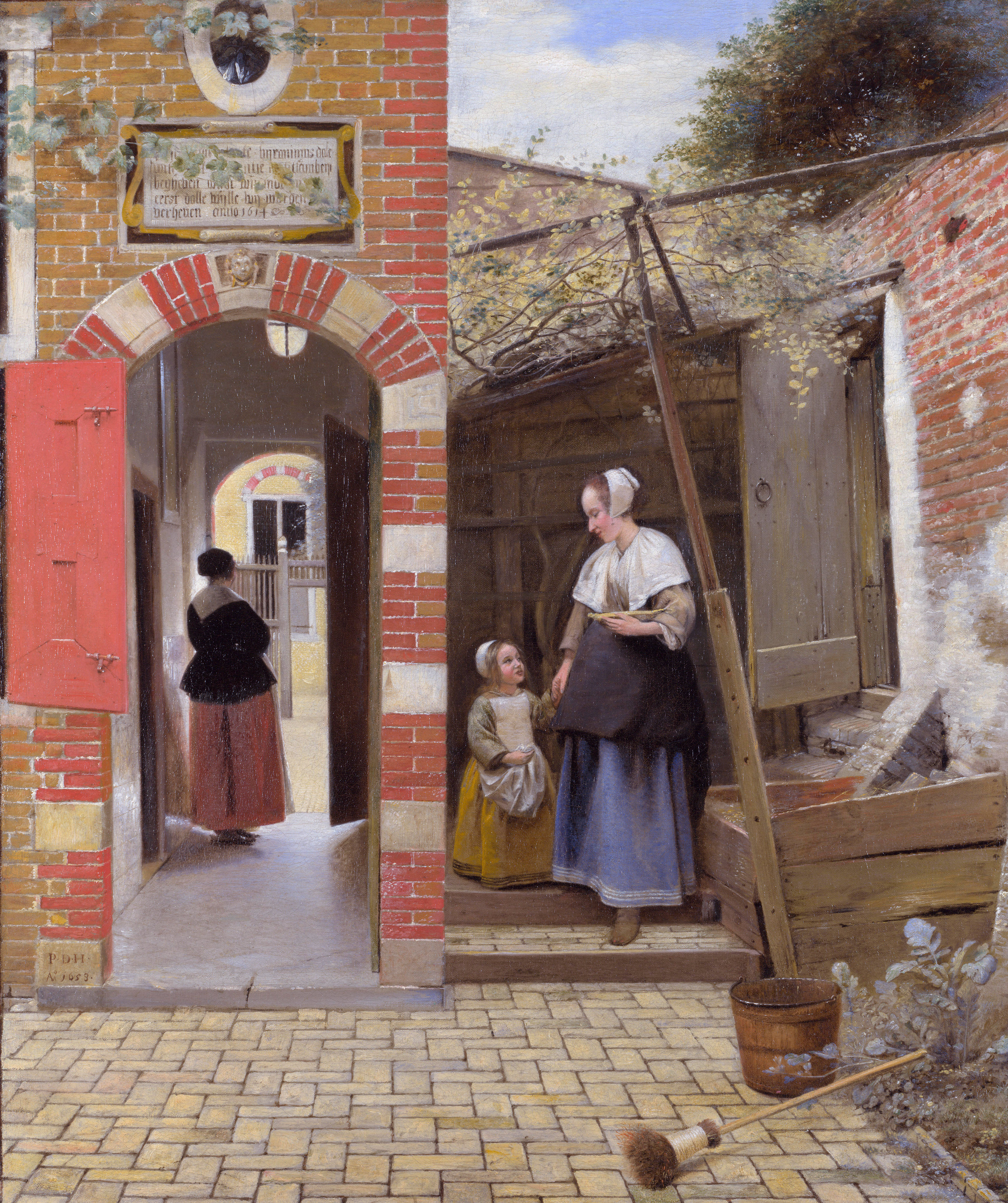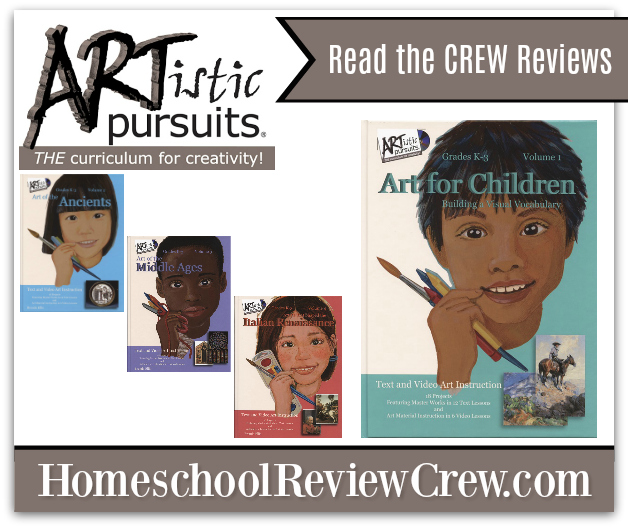- Art for Children, Building a Visual Vocabulary
- Art of the Ancients
- Art of the Middle Ages
- Artists that Shaped the Italian Renaissance
- Art of the Northern Countries, Renaissance to Realism
- Art of the Impressionists
Each book is intended to be a one-semester study, presented approximately at a rate of one lesson a week. The set is available as individual volume purchases, or as a complete set. For our review, we received the first book in the series, Art for Children, Building a Visual Vocabulary.
This text and video art instruction contained 18 lessons in total; 12 text-based lessons featured works of master artists, while the remainings six were video-based instruction on using art materials.
The book teaches are the concepts of "what artists do." It begins with "Artists compose."
This foundational book contains material featured in the larger Early Elementary Volume 1 book. (You can read our review of that here.) However, length notwithstanding, it is not precisely the same program. I feel that new book is almost "ARTistic Pursuits Lite." This book uses the same hands-on learning projects but has fewer questions that examine the individual pictures.
(The current text is on the left, the older book is the spiral bound volume to the right.) While I appreciate the larger photography, I was surprised to see the lesson to have less opportunity to dig into the picture.
I also was shocked to discover the photo has been mistitled in both books. When we reviewed the program in the past, I took it at face value. This spring, Neal and I experienced an incredible vacation that included a guided, "Highlights of the Dutch Masters" tour of the Rijksmuseum in Amsterdam. As I flipped to this page, I thought "Wait, I think we saw this!" (When you only have two hours to see as much as you can cram in, paintings and titles, unfortunately, start to meld in your head.)
Eh, not quite. But it was a house in Delft. This 1670 painting, entitled View of the Houses in Delft, Known as "The Little Street" is by Johannes Vermeer, a contemporary of Pieter DeHooch. Homeschoolers love rabbit holes, so as I started down this one, I learned from the UK's National Gallery that the painting pictured below is actually The Courtyard of a House in Delft.
 |
| Public domain via Wikimedia Commons |
One of his favorite lessons was about observation - just going outside and looking around, and painting what you see.
Here, he combined what he remembered from the lesson on imagination (our house doesn't quite have this color palette) with a newer lesson on observation, and painted a bird flying over the sunny field in front of our house. (It's convenient that we have an Incredible Hulk willing to act as painting stand, isn't it?)
This book contains mostly Masters paintings, and the activities revolve around drawing and painting. There are sculpture choices, including Boy with Bagpipes and Young Bear, that instigates a discussion of form. Instead of painting, construction paper pieces are layered to create paper forms.
A helpful, detailed materials list is included so that the parent/teacher can procure the supplies at the start of the course, and not have to put off instruction because she doesn't have something on hand. The program suggests specific brands of materials. While these brands are not mandatory, you should try to purchase similar quality items. If you've ever been tempted to buy the cheaper, no-name crayons instead of Crayolas to save a few cents, you've seen how art supplies are something where you truly "get what you pay for." The items they suggest are not cheap, but they aren't expensive either. Let's call these supplies what they are -- an investment in your child's education.
ARTistic Pursuits also offers a "complete" supply pack kit for each level if you'd prefer everything in one box. It is independent of the book order, so you can easily increase or restock your supplies if you wish to use the curriculum with more than one child.
The DVD set was a welcome addition to the program. Included are a standard DVD disc and a Blue-ray version. (Matthew tells me that if you don't have an actual Blue-Ray player, Sony Playstations (PS3 and higher) and North American-purchased Microsoft XBox One video game consoles should be able to play Blue-ray discs. I was unable to check this as we do not have either device.) The DVDs added both vocabulary concepts, as well as demonstrated how to use the art materials in the program. While I have an arts degree, my background is in performing arts, not visual arts; the scale required for theater set design doesn't lend itself to the same techniques used for small paper and canvas works. One of this volume's favorite mediums is watercolor crayons, so the first lesson of the DVD showed students how to create works with these and pencils.
It began with a study in visualizing what you want to draw/paint and then segues into a discussion of composition, line, and color. As the video completes the drawing, it shows how to use watercolor crayons to re-create the colors of your composition.
It also teaches painting techniques, starting with "how to have just enough water on your brush," and how to properly use the brush.
The instructors also recognize students in this age bracket may be a bit enthusiastic in their painting, and show how to fix a painting that may get a little flooded.
It concludes with a reminder of how to clean up after you're done and store your paints and brushes. I honestly think that sometimes it takes outside influence to get a kiddo to clean up properly. Somehow, they accept it as "how it must be done" and not as "mom nagging again." I definitely appreciated this!
Damien hunted the house and looked for items he could compose to create his own picture. He chose his favorite fruit, strawberries, arranged in a bright blue bowl.
The second DVD lesson showed color mixing. For some kids, this will be a reminder (as Damien reminded me, he was in third grade!), but it's a good review of what colors combine to secondary and tertiary colors, but it also shows the technique of how to mix them. As Celia looked over his shoulder, I hear her gasp, "Oh! THAT'S how it works!" No, she wasn't shocked that red and yellow made orange, but she had an "aha" moment watching the mechanics of how the on-screen artist blended them. I wouldn't necessarily recommend the program for middle or high school students- the language and perspective are geared toward the younger student - but if you had older art students, the few minutes on technique in each lesson would be worth sitting in on.
These DVDs are only available with the new book series. I wish they were available as a stand-alone item, especially for those who may already have the older ARTistic Pursuits books and would welcome a video-based supplement.
Overall, this is a good program. I like that it takes only a few minutes a week for me to sit with Damien and read about/discuss a piece of art, and then it allows him near free-reign over the creative process. This makes it more convenient to fit into our week, and more likely that we will be able to keep up with it.
Crew families have been studying art with the first four books in the series,
- Art for Children, Building a Visual Vocabulary
- Art of the Ancients
- Art of the Middle Ages
- Artists that Shaped the Italian Renaissance

©2012- 2017 Adventures with Jude. All rights reserved. All text, photographs, artwork, and other content may not be reproduced or transmitted in any form without the written consent of the author. http://adventureswithjude.com

















No comments:
Post a Comment